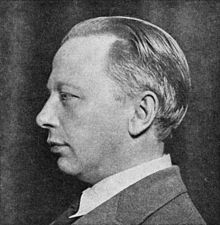International Schubert Competition 1928

The International Schubert Competition 1928 (also 1928 International Columbia Graphophone Competition or Schubert Centennial Contest ) was a composition competition on the occasion of the 100th anniversary of Franz Schubert's death . It was carried out jointly by the Gesellschaft der Musikfreunde in Vienna and the Columbia Graphophone Company . The first prize from a total of 513 entries was awarded to the 6th symphony by the Swedish composer Kurt Atterberg .
Competitive conditions
On June 26, 1927, the British-American record company Columbia Graphophone Company and the Gesellschaft der Musikfreunde in Vienna announced a joint composition competition. The original intention was to have Franz Schubert's B minor symphony (the "unfinished") completed on the occasion of the celebrations on the 100th anniversary of Franz Schubert's death . As a result, the rules for participation were revised several times, not least because of criticism from the professional world. In addition to attempts at completion, original works “in the romantic spirit, from which Schubert's music, especially his unfinished symphony, lives” ( New York Times , October 23, 1927) or “symphonic works in one or more movements, presented as an apotheosis of Dedicated to Schubert's lyrical genius and memory ”(New York Times, October 30, 1927). The orchestral line-up should not, however, significantly exceed that of Schubert.
10 geographical participation zones were created, from which five personalities of musical life (including Maurice Ravel , Ottorino Respighi , Manuel de Falla , Karol Szymanowski and Thomas Beecham ) selected three compositions, with a first (£ 150 and $ 750), a second (£ 50 and $ 250 respectively) and Third Prize (highest appreciation, no monetary reward) were awarded.
The 30 selected works were then judged in Vienna by a final jury consisting of one juror from each of the 10 zones. Jurors were: Walter Damrosch , Franz Schalk , Carl Nielsen , Alfred Bruneau , Max von Schillings , Donald Francis Tovey , Franco Alfano , Emil Młynarski , Adolfo Salazar and Alexander Glasunow .
Results
A total of 513 works were submitted. Also due to the constantly changing regulations, there was a very heterogeneous spectrum of submitted compositions, of which only a minority represented actual attempts to complete the "unfinished". Numerous works were loosely related to the original competition ideals. The winners of the 10 zones were selected:
- I America (USA): 1st Charles Haubiel ( "Karma" ), 2nd Louis Gruenberg ( "The Enchanted Isle" ), 3rd Frederick Stahlberg ( Symphony in E minor )
- II Austria (+ Czechoslovakia, Hungary, Yugoslavia, Romania): 1st Franz Schmidt ( 3rd symphony ), 2nd Hans Gál ( 1st symphony "Sinfonietta" ), 3rd Moni Freidsohn ( symphony in F sharp minor )
- III Scandinavia (Denmark, Sweden, Norway): Kurt Atterberg ( 6th symphony ), 2nd Ludvig Irgens-Jensen ( "Passacaglia" ), 3rd Jens Laursøn Emborg ( 3rd symphony )
- IV France (+ Belgium, Switzerland): 1. Henri Ryder and G. Guillemoteau , 2. Aristide Martz , 3. Otto Rippli (all completions of Schubert's " Unfinished ")
- V Germany (+ Holland): 1st Hermann Wunsch ( 5th Symphony ), 2nd Kurt von Wolfurt ( "Variations and Character Pieces on a Theme by Mozart" ), 3rd Johann Berghout ( Symphony in G major )
- VI England (UK + "the dominions"): 1. Frank Merrick (the final jury considered the most successful completion of Schubert's " Unfinished ") and John St. Anthony Johnson ( "Pax vobiscum" ), 2. Havergal Brian ( "Gothic Symphony" )
- VII Italy: 1. Guido Pannain ( “Sinfonietta” ), 2. Bonaventura Somma (a tone poem, possibly “La Lampada Spenta” ), 3. Pietro Montani (a symphonic suite, probably “Suite umoresca” )
- VIII Poland (+ Finland, Estonia, Latvia, Lithuania): 1. Czesław Marek ( “Sinfonia brevis” ), 2. Witold Maliszewski (completion of Schubert's “ Unfinished ”), 3. Karol Jan Lampe ( symphony )
- IX Spain (+ Portugal): 1. Oscar Esplá ( "Schubertiana" ), 2. Conrado del Campo (completion of Schubert's sketches)
- X Russia (+ Ukraine): 1st Michail Tchernov ( 3rd symphony ), 2nd Wassili Kalafati ( "Légende" )
Main award winner
The three main winners were announced on June 23, 1928, and the award ceremony took place on August 17, 1928:
- 1st Prize: 6th Symphony in C major by Kurt Atterberg (prize money £ 2000 or $ 10,000)
- 2nd prize: 3rd Symphony in A major by Franz Schmidt
- 3rd prize: “Sinfonia brevis” by Czesław Marek (renamed “Sinfonia” when printing ).
The winning works were given a world premiere by renowned orchestras and conductors, as well as being printed by Universal Edition . However, none of the works achieved lasting popularity. Atterberg's 6th Symphony (soon dubbed the " Dollar Symphony" because of the high fee ) was not recorded again until 1992 (on the BIS label) after 1928 and 1943 ; the Mareks Sinfonia was only performed again on the occasion of a few performances in the late 1920s a 1995 recording by the Koch label.
Individual evidence
- ↑ a b quot. n. Christoph Schlüren: Foreword to the score of the 6th Symphony by Kurt Atterberg, Universal Edition, 2002
literature
- Malcolm MacDonald: Czesław Marek and his "Sinfonia" in: Chris Walton, Antonio Baldassare (eds.): Music in Exile: Switzerland and Abroad 1918-45 . Peter Lang AG, Bern, 2005, ISBN 3-03910-492-6 , pp. 207-224